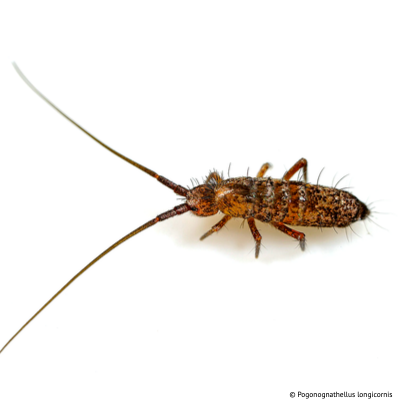
Color: Pale brown to cream.
Size: Rarely more than 1/5 inch long.
Manufacturer Recommended Products And Treatment For Springtail Control
Pests need food, water, and shelter. Often the problem may be solved just by removing these key items. Before even thinking about chemical pest control, it is important to be aware of
| Conducive Condition | Recommendation | |
| 1 | Tree branches on house | Keep tree branches away from house to reduce pest access |
| 2 | Firewood next to foundation | Keep firewood away from house to reduce pest harborage |
| 3 | Debris on crawlspace/next to foundation | Remove wood debris to reduce termite ha rborage area |
| 4 | Excessive plant cover, stump, etc. | Providing spacing between plant cover and structure |
| 5 | Soil above the foundation Ii ne | Keep soil below top of foundation to reduce harbo rage areas |
| 6 | Wood-to-ground contact | Keep soil from touching wood to eliminate termite access |
| 7 | Debris on roof/full gutter | Keep gutter & roof free of debris to reduce insect harborage |
| 8 | Standi ng water near/under structure | Eliminate standing water to reduce pest harbo rage |
| 9 | Mo isture problem under structure | Increase ventilation to reduce pest harbo rage area |
| 10 | Openi ngs at plumbi ng & electronics | Seal opening to reduce pest access |
| 11 | Excessive gaps at windows/doors | Seal gaps to reduce pest access |
| 12 | Lea ky plumb ing fixtures | Repair to reduce moisture for pests |
| 13 | Keep garbage cans covered | Covered to reduce attraction of insects of vertebrate pests |
| 14 | Mo isture damage wood | Repair rotten or damaged wood to reduce insect harborage |
| 15 | Grocery bags stored improperly | Seal paper sacks in containers to reduce i nsect ha rborage areas |
| 16 | Pet food unsealed or left out | Keep pet food in sealed containers and unavailable to pests |
| 17 | Excessive storage conditions | Keep storage areas uncluttered and manageable |
| 18 | Debris below kick plates | Remove kick plates to reduce rodent harborage |
Springtail Control Products for Sale
Wet settings attract springtails, which eat mold, fungi, and decomposing organic matter. When their outdoor habitats dry out, these pests come inside homes for moisture. Springtails don't cause structural harm, but their abundance might frustrate homeowners.
Effective springtail treatment needs moisture control and pest control chemicals. Choose Pest Control Products Depot for the best deals on chemicals controlling springtail infestations.
Types of Springtail Control Products
A variety of springtail control products are available on the market, catering to different levels of infestation and environments. The key products include residual insecticides, direct sprays, and granular treatments.
Residual insecticides offer long-term protection, often remaining active for months after application. Products such as Temprid Aerosol and Cy-Kick CS are commonly used for springtail bug treatment. They can be applied to outdoor areas like foundations, patios, and damp mulch where springtails are most active.
Direct spray insecticides are ideal for treating immediate infestations. These are usually applied directly to springtail habitats. For example, sprays like PT Phantom provide quick results for indoor and outdoor treatment, killing springtails on contact and protecting areas for several weeks.
Granular insecticides like Demand G Granules are perfect for outdoor use, particularly in garden beds or along the perimeter of buildings. These pest control products for springtail management release active ingredients when watered, creating a protective barrier.
Indoor Springtail Killer Products
For indoor infestations, springtail killer indoor treatments often involve a mix of insecticides and moisture control measures. Insecticides, specifically, pressurized insecticides, target cracks, crevices, and other hidden moist areas where springtails tend to hide. These products are highly effective when combined with vacuuming and removing moisture sources like leaks or damp walls.
When using indoor springtail pesticides, ensure that any damp areas are addressed before treatment. Places under kitchen or bathroom sinks, around bathtubs, and in basements are common spots where springtails gather. Products such as Bifen IT work well to eliminate both adult springtails and their breeding environments.
Outdoor Springtail Extermination
Springtail extermination outdoors focuses on reducing the moisture that attracts them and using insecticides around critical entry points. Common treatments include spreading insecticide granules in garden beds or around the foundation. Residual insecticides, such as Onslaught insecticide, provide lasting protection against springtails and other pests, preventing them from entering the home.
To further support pest control, it's vital to eliminate excess moisture around the house by fixing downspouts, removing wet wood or mulch, and sealing entry points. Outdoor pest control products for springtail include Demand G Granules, which can be applied in bands around your property’s perimeter.
Long-Term Springtail Bug Treatment
Effective springtail bug treatment requires ongoing maintenance. Springtails are more likely to return if damp conditions persist. Moisture management is critical in ensuring that springtail populations do not re-establish. For lasting success, consider using residual insecticides that kill springtails over extended periods. A balanced approach of using outdoor springtail control and aerosols for indoor infestations ensures comprehensive management.
Buy the Right Springtail Control Product Today!
When choosing springtail control products, consider the extent of your infestation and the environment you’re treating. For minor indoor problems, direct spray insecticides like Temprid Ready-to-Spray are often sufficient. For larger infestations, especially outdoors, residual insecticides or granular products provide the most lasting protection.
Lastly, check out all our popular and best-selling pest control products at Pest Control Products Depot!
Product Type
14 products
















